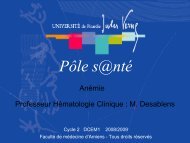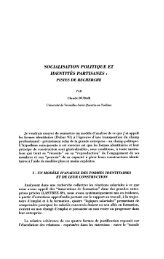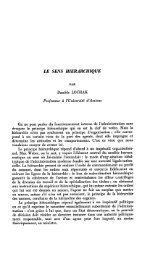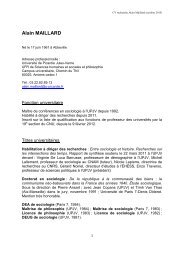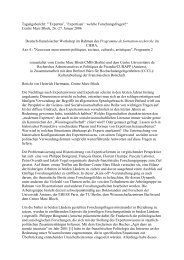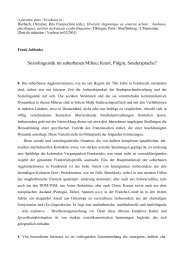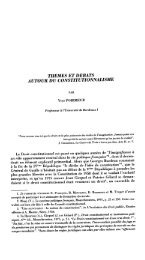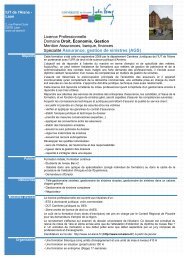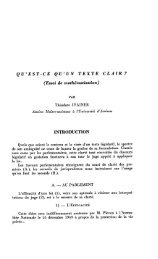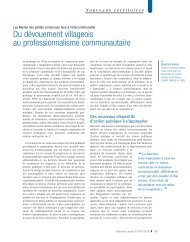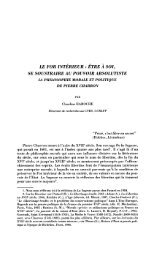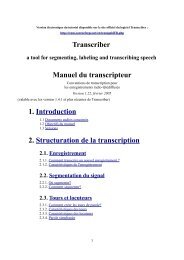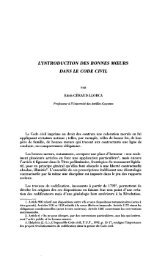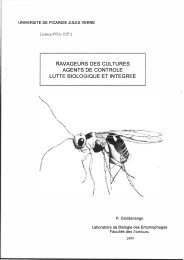Exploring `extreme' physics with an inexpensive plastic toy popper
Exploring `extreme' physics with an inexpensive plastic toy popper
Exploring `extreme' physics with an inexpensive plastic toy popper
You also want an ePaper? Increase the reach of your titles
YUMPU automatically turns print PDFs into web optimized ePapers that Google loves.
The calculation for the time to rise to its maximum<br />
height is<br />
a = vf − vi<br />
t<br />
−9.8ms −2 0 − 4.95 m s−1<br />
=<br />
t<br />
t = 0.505 s.<br />
The calculation for the position of the <strong>popper</strong> after<br />
0.20 s is<br />
d = vit + 1<br />
2 at2<br />
d =(4.95 m s −1 )(0.20 s)+ 1<br />
2 (−9.8ms−2 )(0.20 s) 2<br />
d = 0.79 m.<br />
The preceding calculations are good practice<br />
in using various kinematics equations to <strong>an</strong>alyse<br />
motion. Most students are surprised at how<br />
much information c<strong>an</strong> be gle<strong>an</strong>ed from making<br />
only a measurement of the maximum height of<br />
the <strong>popper</strong>. However, the biggest surprise for<br />
students is the magnitude of acceleration for the<br />
<strong>popper</strong> during the pop. As the <strong>popper</strong> restores<br />
itself, the force it exerts against the surface acts<br />
over a dist<strong>an</strong>ce approximately equal to its radius<br />
(1.25 cm). The acceleration of the <strong>popper</strong> over this<br />
short dist<strong>an</strong>ce is found using:<br />
v 2 f = v2 i<br />
+ 2ad<br />
4.95 m s −1 2 = 0 + 2a (0.0125 m)<br />
a = 980 m s −2 .<br />
Finally, students calculate the time of the pop:<br />
a = vf − vi<br />
t<br />
980 m s −2 = 4.95 m s−1 − 0<br />
t<br />
t = 0.005 05 s.<br />
My students have been encouraged to judge<br />
whether a particular result seems reasonable. Consequently,<br />
they frequently question the magnitude<br />
of the acceleration of the <strong>toy</strong> <strong>popper</strong>. They are<br />
impressed that they c<strong>an</strong> calculate such a high acceleration<br />
from the simple data they have collected.<br />
This acceleration of two orders of magnitude<br />
above the freefall acceleration qualifies as<br />
<strong>Exploring</strong> ‘extreme’ <strong>physics</strong> <strong>with</strong> <strong>an</strong> <strong>inexpensive</strong> <strong>plastic</strong> <strong>toy</strong> <strong>popper</strong><br />
‘extreme’ <strong>physics</strong>. The calculation of the very<br />
small increment of time for the pop also gives students<br />
pause when they consider that the ability to<br />
do this calculation was fully the result of their measurement<br />
of something as simple as the maximum<br />
height of the <strong>popper</strong>.<br />
Analysing the motion of the <strong>toy</strong> <strong>popper</strong>s is a<br />
fun activity for students. They enjoy the action<br />
of the <strong>popper</strong>s <strong>an</strong>d are impressed <strong>with</strong> the high<br />
acceleration <strong>an</strong>d very short time they are able to<br />
calculate. Those who finish a bit earlier th<strong>an</strong> the<br />
rest invariably continue to play <strong>with</strong> their <strong>popper</strong>s<br />
<strong>an</strong>d will often discover that the <strong>popper</strong> goes far<br />
higher if launched from the tip of a finger rather<br />
th<strong>an</strong> a flat surface. The first time I used this<br />
activity, a student discovered this <strong>an</strong>d asked me<br />
about it. I realised that when launched from<br />
the tip of the finger, the force applied during<br />
the restoration of the <strong>popper</strong> acts over a greater<br />
dist<strong>an</strong>ce. When the <strong>popper</strong> rests on a flat surface,<br />
the force applied to that surface begins when the<br />
<strong>popper</strong> is halfway through its restoration, but when<br />
it rests on a fingertip, the force is applied at the<br />
beginning of the restoration. This gives twice the<br />
time <strong>an</strong>d therefore twice the initial speed. Asking<br />
students to explain why the <strong>popper</strong>s rise to a higher<br />
maximum altitude when launched from a fingertip<br />
gets them to think more deeply about the <strong>physics</strong><br />
of the <strong>popper</strong>. I have since included this question<br />
as <strong>an</strong> extension to the calculations in the activity.<br />
The <strong>plastic</strong> <strong>popper</strong> gives students <strong>an</strong> opportunity<br />
to <strong>an</strong>alyse the <strong>physics</strong> of a simple <strong>toy</strong>. Toy<br />
<strong>popper</strong>s c<strong>an</strong> also provide teachers <strong>with</strong> <strong>an</strong> <strong>inexpensive</strong><br />
activity that gives students practice at<br />
<strong>an</strong>alysing motion as well as safe <strong>an</strong>d direct access<br />
to extreme <strong>physics</strong>.<br />
Received 21 June 2008<br />
doi:10.1088/0031-9120/43/5/004<br />
References<br />
[1] www.windycitynovelties.com/EPaysoft/Cart/<br />
product.asp?ITEM ID=6495&CatID=0<br />
[2] www.centurynovelty.com/detail 306 209-231.html<br />
[3] www.craftpacks.co.uk/#prod1725<br />
David Lapp has 22 years of high school<br />
<strong>physics</strong> teaching experience. The last 18<br />
years he has taught at Tamalpais High<br />
School in Mill Valley, California. He is<br />
also <strong>an</strong> occasional lecturer in the<br />
Department of Physics <strong>an</strong>d Astronomy at<br />
Sonoma State University. His interests<br />
are in <strong>physics</strong> education <strong>an</strong>d specifically<br />
in developing methods for making<br />
<strong>physics</strong> accessible to all students.<br />
September 2008 P HYSICS E DUCATION 493



